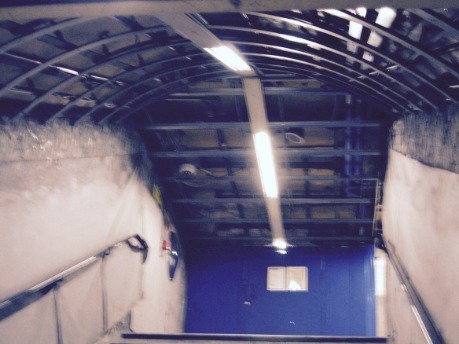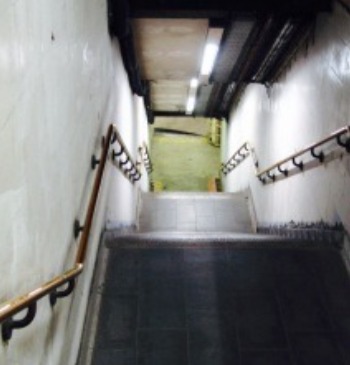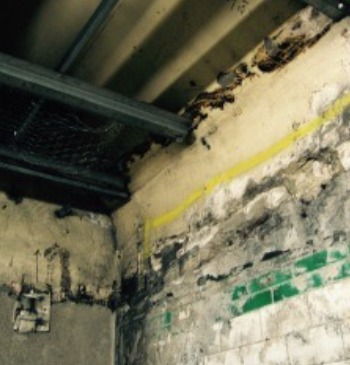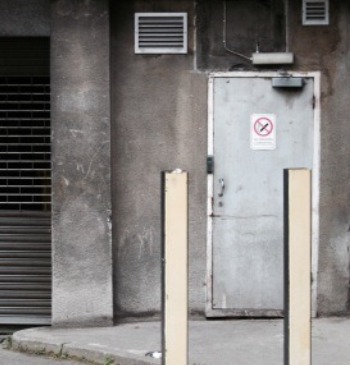Bunker
In 1945 the urbanist and philosopher, Paul Virilio discovered the sea: he described the place as a void ‘with that particular emptiness you feel in abandoned places.’ Everything had been blown up, the beach was heavily mined and deserted and the streets were empty – La Baule on the southern Brittany coast was so strategically important to the occupying Germans that troops continued to fight 3 days after the surrender.

Bunker Archeology (Centre Georges Pompidou, 1975), (English translation, Princeton Architectural Press, 1994) was published as part of an exhibition of these photographs taken between 1958 and 1965, arranged by the Centre for Industrial Creation. In it Virilio considers how the bunker has re-organised the landscape into a series of defensive constructions, frontiers and disequilibriums. In peacetime the bunker is seen as ‘a survival machine, its half-buried mass a reflection of our power over death’ or ‘a habitat, a kind of clothing or a collective armor’. ‘Spun from a network under tension with the landscape … invisible and immaterial … that escapes our gaze’ enabling it to hide from view, coalescing with the earth, prematurely worn and smoothed and nestling in an uninterrupted expanse of space, ‘disappearing from our perception’, ‘I felt as though a subterranean civilization had sprung up from the ground.’
The bunker, he argues, has become a myth, both present and absent at the same time. Present as an object of disgust – not part of an open, civilian architecture – and absent as its essence as a fortress lies underfoot and invisible. Architecturally, the blockhouse put an end to ‘forward’ and ‘rear’ and began anew with ‘above’ and ‘below’, lying ‘abandoned on the sand like the skin of a species that has disappeared’.
There seems to be an enduring cultural interest in the idea (and reality) of the bunker. In 2009, the Polish artist Robert Kusmirowski’s installation at the Barbican directed the viewer through a set of heavy metal doors along a rusting walkway and down a set of stairs into a warren of dark rooms. In an apparent reproduction of a World War Two concrete bunker, old documents, communications systems and work stations which appeared to date from the 1940s were rendered in meticulous detail. Derelict industrial equipment, rusting generators, old cans and survival supplies, corroded pipes and boilers and a railtrack which ran the length of the installation, segued into the Barbican’s hammered concrete pillars and its location on the site of devastation caused by World War Two bombing.
Kusmirowski’s research included visits to military bunkers and the close study of their photographic documentation and every element of his installation was painstakingly rendered. Born in 1973, his own history included the rise of the Polish trade union movement Solidarność, founded in 1980 at the Lenin shipyard in Gdańsk with the subsequent imposition of martial law and years of political repression. But an importance in the sense of collective identity fostered by Communism was evoked in Kusmirowski’s 2003 installation, Double V, which reconstructed in the gallery a worker’s apartment with its mirror image recreated on the other side of a glass panel, including details such as a plate of biscuits and a portrait of Lenin.
Virilio proposed that the shelter is an enduring metaphor for anguish and it is perhaps timely that one of the site-specific artworks for this year’s Frieze Art Fair in New York is modeled on the Anderson bomb shelter distributed in Britain during the Second World War. Elaine Cameron-Weir’s temporary structure on Randall’s Island is dug into the earth and features a corrugated metal roof and sandbags.


The bunker has associations with aggression and fear, conflict and vulnerability: to create a ‘bunker’ somehow becomes a ‘political’ act and for Cameron-Weir ‘the action of making art is political. There’s a lot of aggression in what I’m making right now’ (FT, 30.04.17).
The bunker hovers on the brink of the past and the obsolete and of the potential of renewal: its ubiquitous concrete make-up makes it impossible to remove from the landscape – it’s easier to reconstitute it as ‘heritage’ architecture. Partly submerged, bunkers are mostly neglected structures and the internet teems with various ‘guerrilla explorers’ who breach their securities and post photographs of their forbidden interiors online. Powerful flashlights reveal graffiti-covered walls, broken bottles, bits of furniture, cast iron machinery and networks of tunnels and shafts. The Kingsway Exchange, a deep-level shelter built underneath Chancery Lane tube station in the 1940s, was one of eight built in London designed to house up to 8,000 people. After the war it was expanded to use as a Cold War government shelter and communications system.



The idea of the bunker resonates with the rise of nationalisms or ideologies, xenophobia, violence and the return of borders and can’t, it seems be erased either from the landscape or from history. There are allusions to all these, and of history inscribed in space, in their lingering sense of abandonment yet sinister readiness to be reconstituted.



